Costumes & Characters
"One of the things we wanted to do with Dralion is to have people
rediscover the power and importance of the four elements. We take them for
granted in our daily lives. Values have been displaced. Maybe one of
the goals of Dralion is to help re-establish a connection with the
elements." - François Barbeau, Costume Designer
The primary source of inspiration for the costumes of Dralion come
from China, India and Africa. The palette favors vibrant, solid
colors - far from pastels - while the shapes are guided by the
artists' movements and choreography. Working closely with the Director
and drawing his inspiration from the mythical fantasy world of Dralion,
François Barbeau set out to create costumes that reflect the distinctive
features of the four elements and the families of associated charters.
"Basically, the costumes are simple, and the accent is very much on
color," says Barbeau, who won an Emmy for his "Dralion" designs. "The
colors are very, very powerful — there are no pastels. When we deal
with the element of water it is all green, because looking down at
China from the airplane I saw many green lakes below, like pieces
of jade." Fire is red, of course. The earth is represented with
browns and ochre and reddish browns, and the air is blue. It's very
basic, but quite sophisticated."
One challenge for Barbeau was
making the shimmering, "sculptural" costumes durable enough to hold
up well on tour: "The fabric is dyed in spectacular ways, but each
piece is designed to last," he states. He adds that typically a
performer will wear five different costumes in the show, and must
make presto offstage changes so the visual spell is never broken
for audiences.
| |
The male singer's headdress is inspired by one discovered in China. To create the
texture on the front of the costume, little plastic soldiers were glued on and then
molded into different shapes.
|
Over 5,000 metres of fabric were used in creating the costumes. The fabrics come
from regions around the globe, including China, the United States, Italy, France,
England and Quebec.
Natural and synthetic fabrics such as silk, lycra, velvet, leather and cotton blend
together harmoniously in Dralion’s costumes. Marrying a wide variety of fabrics helps
ensure that the artists' specific costume needs can be met.
Materials that might be considered somewhat unusual were used in accessories and to
add finishing touches to costumes: horse hair, raffia, metal, window screen, emu
feathers, crystal, styrofoam, plastic, fun fur, springs and even an array of hardware.



The Elements
As the wheel of time turns, the universe, like the acrobat, searches for a
perfect balance among the elements. Air, water, fire and earth assume human form
and evolve into worlds defined by their own vivid colours.
Azala is the Element of Air. She is the keeper of the sun and the guardian of
immortality, watching over the heavens to protect all those who take to the skies. Azala
is identified by the color of the skies -- Blue.
Oceane is the Element of Water. With her exotic dance, she has the power to control
all the waters of the world. You can itentify Oceane by the color of the waters -- Aqua Green.
Gaya is the Element of Earth. She is warm, comforting and rhythmic. Her tribal dance
echos the pulse of human life. Gaya is identified by the soils of Earth -- Brown.
Yao is the element of Fire. He is a warrior and a shaman; the fiery demon's guide.
Yao can be itentified by the color of flame -- Red.
Little Budda
The Little Buddha is the chosen child. Although it possesses special powers that will allow it
to eventually become an Âme-Force, it dreams of being just a regular child.
L'Âme-Force
The voices of Dralion sing an invented language to which only Cirque du Soleil holds
the key. Their mysterious accents echo down through time: L’Âme-Force symbolises ultimate
harmony between the four elements.
Clowns
Clowning in Dralion has been taken on by two distinct duo acts simultaneously -
one using Michael Dallaire's co-designed segments for the show, and another
using their own outside material. This has created a unique comedic experience
for Dralion.
The First Clowns
Michael Dallaire may designed the clown acts for Dralion's premiere run, but
Philippe Delaitre (Popo), Robert Jetté, Ben-Amar Djalal, and Aline Muhein
did not last long in their roles and were replaced - at the latest - by
the beginning of the Toronto run on July 29, 1999.
Joe de Paul / "Giovanni"
Each appearance of the diminutive Joe de Paul, aptly born on April Fool’s Day,
was always eagerly welcomed with applause and cheers. His straight-faced double
takes are priceless! Joe is squat and rubbery-limbed and loves to plop
himself, babylike, into people's arms. In a comical display of polygamy, he
repeatedly selects from the audience women who tower over him, draped veils
on their heads and made each his bride - at least until show time. And during
the show, when Joe runs afowl of a trio of Dralion's gods, he enlists the help
of a reluctant audience member who's oder-eater's will... he hopes... offend
them away. The duo's later spoof of the Aerial Pas de Deux artists is priceless.
Not to mention the broom yielding Yao knock-off. While the role originated with
Joe de Paul (1999-2001), the character has also been played by Blas Villalpando
(2001) and Philippe Aymard (2001-2008, 2009-2010), amongst many others over
the years. [A female version of Giovanni, nammed "Giovanna" was
portrayed by Jessica Green in 2003.]
Les Voila! (1999-2001)
While Les Voila! were not the original comedic act for Dralion, the inimitable
comic duo made up of Johnny Filion & Soizick Hébert have become the
perennial favorites amongst fans. They get more laughs out of a bullhorn and a
ukulele than should be allowed. Filion, with his too-short trousers, Coke-bottle
thick spectacles and nervous Peter Lorre-like snorting laughter (think heavy
breathing and/or snickering breathily) magnified by his ever-present megaphone,
brings on belly laughs at every turn. And tall, reedy Soizick Hébert, with a
wacky rotating topknot, is particularly droll as a cheerleader juggling
weightless goassamer Day-Glo colored scarves - more challenging than it
sounds - while accompanied and eventually distracted by Filion's frantic drum
solo. Their duets are the comedic highlights of the show, especially when
Filion starts strumming his contrabass like a guitar, then walks up one side
of it and keeps playing without missing a beat. And when the duo show up one
last time in a hilarious parody of the show's acrobatic excesses - from
Hébert's lampoon of the vocalists to Filion's body-beautiful mockery of the
juggler - it's a bright, light climax that defuses much of the pomposity of
the ever-so-esoteric acts that have come before. The Cirque has a laugh with
us at its own artistic pretensions.
The Mad Italian Waiters
John Gilkey was asked to replace Les Voila, who were leaving rather last
minute, in January of 2001. He was interested only if he could create new numbers
and work with a partner; Cirque agreed. John called up his friend Gonzalo
Gonzalo Muñoz Ferrer in New York City and the two of them came up with a couple
of new numbers within a week. After approval by Guy Carron, John and Gonzalo
flew to Miami to be integrated into the show. They replaced two of Les Voila's
acts with their new "Mad Italian Waiter" routines, and performed modified versions
of the other two acts that were created by the original clown director. The
acts that John and Gonzalo presented were, in his words, "out there" - and they
really are.
"Alberti" is a bald-headed man with a tuft of hair parted in as a
comb-over. He is dressed in a suit and appears rotund (he has a belly). Attached
to his left hand is a bowling ball, which he has a devil of a time trying to get
off. His friend, "Vincenti" (Gonzalo) is a scruffy looking man with a suit that
doesn't fit right, and hair sticking straight out in all directions from his head.
One routine features one clown stapling clumps of hair (retrieved from various parts
of his anatomy) to the other’s head. In another, the clown is repeatedly hit in
the face by his protruding belly. The exaggerated motions he goes through (and
replays in slow-motion) were enough to bring the house down. But the act turns
from laughter to confusion when he "dies" from this apparent attack and his
partner fusses over him. Eventually his stomach begins to glow and he "rises
from the dead". At this point he began to ascend into the sky (via the rotating
ring that is a prominant feature of the set). John Gilkey only performed for
about six months before being replaced with Colin Gee, and both rolls have been
filled by a variety of others over the years.
|
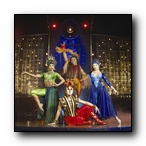
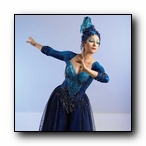
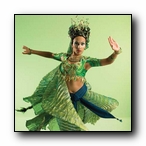
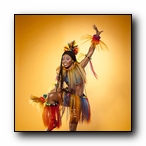
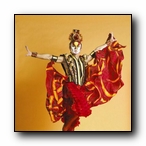
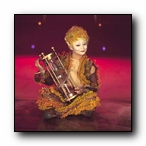
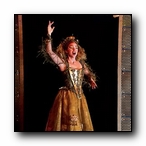
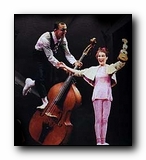
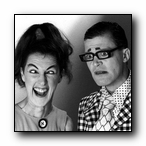
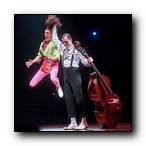
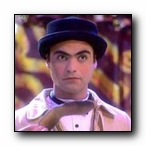
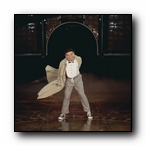
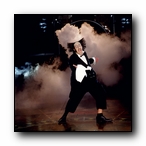
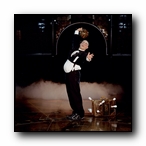
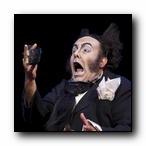
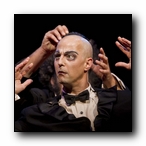
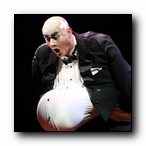
|
|
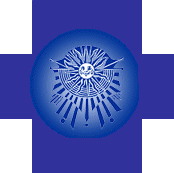
![]()




